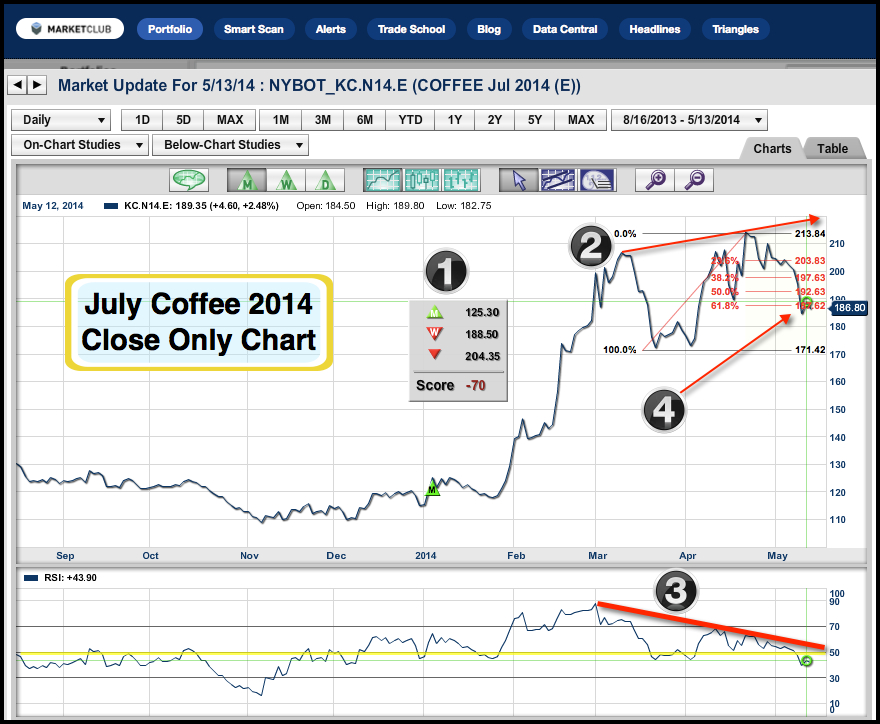One of the many things I enjoy about MarketClub is interacting with our members and discussing the markets. One of our members recently asked about the coffee market and what I thought about it.
"Would love to see your analysis of coffee as a special situation. Know it is currently in a pullback. Monthly is still green. Sounds like the shortage is expected to continue and increase. That should mean prices will go even higher. The question is where to get back in. I have been using the ETF JO to play it. Have had a good run with in and outs following TT's, RSI, and other. Expect we could all benefit from a right time buy and proper trailing stop and just following it for a while?"
As you can see, Harold is pretty smart investor and a valued member of MarketClub. He's also taken some nice profits out of the coffee market.
So without further ado, here are my thoughts on the July Coffee (NYMEX:KT.N14.E) market. Now remember, Harold is trading the ETF Ipath DJ-UBS Coffee Trust Sub-Index (PACF:JO). This ETF pretty much mimics what the coffee market is doing.
Chart Code
1. Trade Triangles
2. Price negative divergence
3. RSI negative divergence
4. Fibonacci support area
When trading in the futures markets, we are relying on the weekly Trade Triangle for the trend and the daily Trade Triangles for timing. It's also important not to forget the monthly Trade Triangle, as it shows the longer-term trend.
If you're not familiar with how you can use the Trade Triangles to trade futures, here are the rules again for members.
Use the weekly Trade Triangle to determine the major trend and initial positions. Use the daily Trade Triangles for timing purposes.
Let me give you an example: if the last weekly Trade Triangle is GREEN, this indicates that the major trend is up for that market. You would use the initial GREEN weekly Trade Triangle as an entry point. You would then use the next RED daily Trade Triangle as an exit point. You would only reenter a long position if and when a GREEN daily Trade Triangle kicked in. You would then use the next RED daily Trade Triangle as an exit point, provided that the GREEN weekly Trade Triangle is still in place and the trend is positive for that market. The reverse is true when you have a RED weekly Trade Triangle. You would use the initial RED weekly Trade Triangle as an entry point for a short position. You would then use the next GREEN daily Trade Triangle as an exit point.
When I started looking at July Coffee (NYMEX:KT.N14.E), the first thing I noticed was the market was pulling back from a recent high. When I see a market pulling back from a high, I immediately use the Fibonacci tool to find the next level of support. This is one of the most useful tools that a trader can have in his toolbox. In theory, the market will move up and pull back, and when it pulls back it should begin to find support at the 50% to 61.2% of the entire move. Using the Fibonacci tool, measure from the highs to the recent lows and that's where the market should find support. Right now, coffee is into an area where it should begin to find support.
Another standout feature to me in July Coffee (NYMEX:KT.N14.E) was the fact that it had a very strong price negative divergence. This means is that while prices were making new highs, the RSI indicator was not matching the market's momentum. This is often an early warning sign that something is amiss in the latest up-move. As it turns out, it happened to be right on the money, as coffee fell back from making new highs.
To trade July Coffee (NYMEX:KT.N14.E) or the Ipath DJ-UBS Coffee Trust Sub-Index (PACF:JO), I would look for the RSI indicator to close over the 50 line. This would indicate that the short-term trend was up. If you want to be a little bit more conservative, wait to see the weekly Trade Triangle turn green, that could be an ideal time to purchase either July coffee futures or the ETF JO.
Every success with MarketClub,
Adam Hewison
President, INO.com
Co-Creator, MarketClub


Coffee Lower, the COT report concurs. The commercial shorts (sellers e.g. Brazil) minus the commercial longs (buyers e.g. Starbucks) has attained a historically high level: KC on the below chart.
https://dl.dropboxusercontent.com/u/29771494/COTReport/COTReportDouble.html
Good to compare DX to all dollar denominated futures DX / ???. And with the dollar looking to have bottomed, lower grains and softs looks likely.